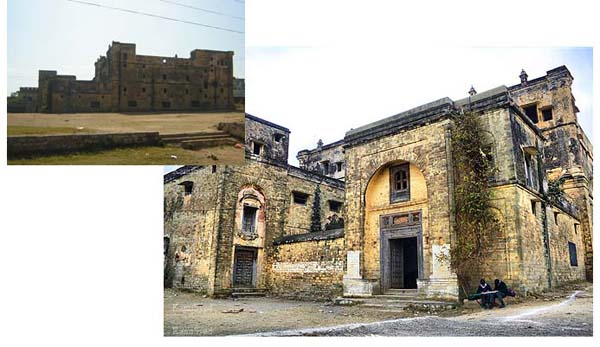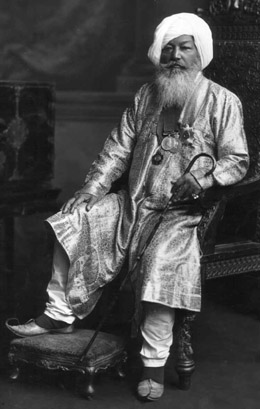By Mohammed Ayaiz
Kallar Saydan has long been the central and cultural hub for the region of Rawalpindi in Pakistan. It has developed in to a busy market place, with a wide variety of shops from modern jewelers to old darji shops. Hidden away with in the town, away from the shops and the main road is the “Bedi Palace”. For many years, this palace served as the Government High School. Due to the current state (and probably for the future) and economy of the country, there is today no plan in place to preserve such buildings. Poverty and the quality and cost of living are such that people have other more basic priorities of life.

The palace is situated away from the main roads and nearly on the edge of the town.
As you walk through the narrow galliyan in the cool shade, the hustle of the town dies down behind you. The entrance is via the school ground and as soon as you step through the small door of the large wrought iron gates, the narrow entrance suddenly widen in what is called the “school ground”. It is quite a large area and barely resembles a school as we know them here in the West. You will set eyes on a very old, large multi storey building, this is “Bedi Palace” It was built by Sir Baba Khem Sing Bedi, in the later half of the 19th century. The structure is enormous; it is a house, but a very big one!
Upon entering the palace, you realize that it was not just any house. The wooden doors and windows were hand made from some of the finest wood and carved with intricate designs finished with copper studs, some of the most beautiful art work I have ever seen. The first door leads to the main entrance of the building. This in turn leads to another entrance of similar grandeur. Just the design of the bay windows and the brick work are fantastic and were probably way ahead of their time. Although used as a school it retains much of the original features. Needless to say much of the precious artwork has been destroyed and some minor repair has defaced some of the interior of the building. The main central court of the palace has an open top roof and this is a unique feature.
Some of the art work is still in very good condition, though weathered. The colors have not faded that much and the detail in all these pictures is very good, although scratched and damaged in many places. I have been told that there was an exquisite painting of the golden temple of Amritsar on one of the internal walls. Sadly, it was painted over some years ago; I somehow found this really sad and upsetting. Maybe it’s my love of heritage, that I saw it as a loss. Maybe it would’ve been nice to have seen the picture painted by hands that were once alive. Places such as this palace, are literal time machines that hold the essence of the very people that once inhabited this area. There are pictures of people with names which could be Gurmukhi or Hindi along with bird’s (looks like a parrot) & vases of flowers.
The remainder of the building is made up of various rooms and to be honest it’s got so many rooms I lost count how many exactly. There are original fire places still in place. The view from the top floors is great, you can see all round the town and into the distance, it is a truly wonderful view. But from here on, the future is unclear for this building, and only time will tell what the destiny will be in the coming years. It is a gentle reminder of what was and what will become. This is a building whose purpose is now unclear. Day by day it is losing its identity, it is in fact lost, hence my title, the lost palace.
Courtesy: www.pothwar.com
Sir Baba Khem Sing Bedi, was one of the founders of the Singh Sabha Movement . He was born on 21st February 1832 at Kallar and was a direct descendant, in the thirteenth place, of Guru Nanak Dev, the founder of Sikhism. In the year 1857, Baba Khem Singh Bedi assisted the British in suppressing a local rebellion in the Gugera district. He was appointed a magistrate in 1877 and nominated to the Viceroy’s Legislative Council in 1893, and again in 1897 when the Indian Council Act was extended to the Punjab. He was knighted in 1898.
By nature Baba Khem Singh Bedi was a humanitarian. With his help at least fifty schools for boys and girls were established in the Punjab. His generosity was such that he donated substantial sums of money for religious and charitable purposes. Baba Khem Singh lived in handsome style, his possessions in land in Montgomery district alone amounted to 28,272 acres. He enjoyed the admiration of hundreds of thousands of followers in Western Punjab and what later became the North-West Frontier Province. While on a tour of the latter in the spring of 1905, he suddenly fell ill and died at Montgomery on 10 April 1905.
Move mouse over thumbnails for larger view.
|
|

Sir Baba Khem Singh Bedi, dressed for the Coronation of King Edward VII held in the year 1902. He is wearing a splendid robe known as choga, made of gold brocade probably woven in Benares and made especially in Kashmir or Punjab in the traditionally wide-cut choga style. The large boteh or kalka motifs in the corners of the robe are the typical designs popular in North India at the time. Under the choga he wears a typical plain white cotton pajama and a fantastic pair of leather slippers commonly called “ Khussa” with curling toes and all. These are still in fashion today.
|

